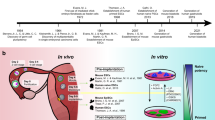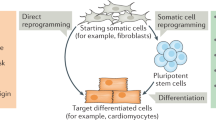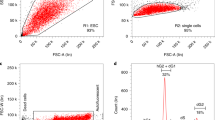Abstract
Pluripotent stem cells can be expanded seemingly indefinitely in culture, maintain a normal karyotype and have the potential to generate any cell type in the body. As such they represent an incredible resource for the repair of diseased or damaged tissues in our bodies. These cells also promise to open a new window into the embryonic development of our species.
This is a preview of subscription content, access via your institution
Access options
Subscribe to this journal
Receive 51 print issues and online access
$199.00 per year
only $3.90 per issue
Buy this article
- Purchase on Springer Link
- Instant access to full article PDF
Prices may be subject to local taxes which are calculated during checkout



Similar content being viewed by others
References
Stevens, L. C. The biology of teratomas. Adv. Morphogen. 6, 1–31 (1967).
Jiang, L. I. & Nadeau, J. H. 129/Sv mice—a model system for studying germ cell biology and testicular cancer. Mammal. Genome 12, 89–94 (2001).
Kleinsmtih, L. J. & Pierce, G. B. Multipotentiality of single embryonal carcinoma cells. Cancer Res. 24, 1544–1552 (1964).
Stevens, L. C. Origin of testicular teratomas from primordial germ cells in mice. J. Natl Cancer Inst. 38, 549–552 (1967).
Skakkebaek, N. E., Berthelsen, J. G., Giwercman, A. & Muller, J. Carcinoma-in-situ of the testis: possible origin from gonocytes and precursor of all types of germ cell tumours except spermatocytoma. Int. J. Androl. 10, 19–28 (1987).
Andrews, P. W. Teratocarcinomas and human embryology: pluripotent human EC cell lines. Acta Pathol. Microbiol. Immunol. Scand. 106, 158–167; discussion 167–168 (1998).
Kahan, B. W. & Ephrussi, B. Developmental potentialities of clonal in vitro cultures of mouse testicular teratoma. J. Natl Cancer Inst. 44, 1015–1036 (1970).
Rosenthal, M. D., Wishnow, R. M. & Sato, G. H. In vitro growth and differentiation of clonal populations of multipotential mouse cells derived from a transplantable testicular teratocarcinoma. J. Natl Cancer Inst. 44, 1001–1014 (1970).
Evans, M. J. The isolation and properties of a clonal tissue culture strain of pluripotent mouse teratoma cells. J. Embryol. Exp. Morphol. 28, 163–176 (1972).
Evans, M. J. & Kaufman, M. H. Establishment in culture of pluripotential cells from mouse embryos. Nature 292, 154–156 (1981).
Martin, G. R. Isolation of a pluripotent cell line from early mouse embryos cultured in medium conditioned by teratocarcinoma stem cells. Proc. Natl Acad. Sci. USA 78, 7634–7638 (1981).
Resnick, J. L., Bixler, L. S., Cheng, L. & Donovan, P. J. Long-term proliferation of mouse primordial germ cells in culture. Nature 359, 550–551 (1992).
Matsui, Y., Zsebo, K. & Hogan, B. L. Derivation of pluripotential embryonic stem cells from murine primordial germ cells in culture. Cell 70, 841–847 (1992).
Thomson, J. A. et al. Embryonic stem cell lines derived from human blastocysts. Science 282, 1145–1147 (1998).
Shamblott, M. J. et al. Derivation of pluripotent stem cells from cultured human primordial germ cells. Proc. Natl Acad. Sci. USA 95, 13726–13731 (1998).
Reubinoff, B. E., Pera, M. F., Fong, C. Y., Trounson, A. & Bongso, A. Embryonic stem cell lines from human blastocysts: somatic differentiation in vitro. Nature Biotechnol. 18, 399–404 (2000).
Thomson, J. A. et al. Isolation of a primate embryonic stem cell line. Proc. Natl Acad. Sci. USA 92, 7844–7848 (1995).
Thomson, J. A. et al. Pluripotent cell lines derived from common marmoset (Callithrix jacchus) blastocysts. Biol. Reprod. 55, 254–259 (1996).
Pera, M. F., Reubinoff, B. & Trounson, A. Human embryonic stem cells. J. Cell Sci. 113, 5–10 (2000).
Pesce, M., Gross, M. K. & Scholer, H. R. In line with our ancestors: Oct-4 and the mammalian germ. BioEssays 20, 722–732 (1998).
Nichols, J. et al. Formation of pluripotent stem cells in the mammalian embryo depends on the POU transcription factor Oct4. Cell 95, 379–391 (1998).
Niwa, H., Miyazaki, J. & Smith, A. G. Quantitative expression of Oct-3/4 defines differentiation, dedifferentiation or self-renewal of ES cells. Nature Genet. 24, 372–376 (2000).
Martin, G. R. Teratocarcinomas and mammalian embryogenesis. Science 209, 768–776 (1980).
Smith, A. in Stem Cell Biology 205–230 (Cold Spring Harbor Laboratory Press, 2001).
Bradley, A., Evans, M., Kaufman, M. H. & Robertson, E. Formation of germ-line chimaeras from embryo-derived teratocarcinoma cell lines. Nature 309, 255–256 (1984).
Labosky, P. A., Barlow, D. P. & Hogan, B. L. Embryonic germ cell lines and their derivation from mouse primordial germ cells. Ciba Found. Symp. 182, 157–168; discussion 168–178 (1994).
Labosky, P. A., Barlow, D. P. & Hogan, B. L. Mouse embryonic germ (EG) cell lines: transmission through the germline and differences in the methylation imprint of insulin-like growth factor 2 receptor (Igf2r) gene compared with embryonic stem (ES) cell lines. Development 120, 3197–3204 (1994).
Stewart, C. L., Gadi, I. & Bhatt, H. Stem cells from primordial germ cells can reenter the germ line. Dev. Biol. 161, 626–628 (1994).
Brinster, R. L. The effect of cells transferred into the mouse blastocyst on subsequent development. J. Exp. Med. 140, 1049–1056 (1974).
Illmensee, K. & Mintz, B. Totipotency and normal differentiation of single teratocarcinoma cells cloned by injection into blastocysts. Proc. Natl Acad. Sci. USA 73, 549–553 (1976).
Papaioannou, V. E., Gardner, R. L., McBurney, M. W., Babinet, C. & Evans, M. J. Participation of cultured teratocarcinoma cells in mouse embryogenesis. J. Embryol. Exp. Morphol. 44, 93–104 (1978).
Papaioannou, V. E., McBurney, M. W., Gardner, R. L. & Evans, M. J. Fate of teratocarcinoma cells injected into early mouse embryos. Nature 258, 70–73 (1975).
Nishikawa, S. I., Nishikawa, S., Hirashima, M., Matsuyoshi, N. & Kodama, H. Progressive lineage analysis by cell sorting and culture identifies FLK1+VE-cadherin+ cells at a diverging point of endothelial and hemopoietic lineages. Development 125, 1747–1757 (1998).
Wiles, M. V. & Keller, G. Multiple hematopoietic lineages develop from embryonic stem (ES) cells in culture. Development 111, 259–267 (1991).
Nakano, T., Kodama, H. & Honjo, T. Generation of lymphohematopoietic cells from embryonic stem cells in culture. Science 265, 1098–1101 (1994).
Li, M., Pevny, L., Lovell-Badge, R. & Smith, A. Generation of purified neural precursors from embryonic stem cells by lineage selection. Curr. Biol. 8, 971–974 (1998).
Muller, M. et al. Selection of ventricular-like cardiomyocytes from ES cells in vitro. FASEB J. 14, 2540–2548 (2000).
Eiges, R. et al. Establishment of human embryonic stem cell-transfected clones carrying a marker for undifferentiated cells. Curr. Biol. 11, 514–518 (2001).
Bjornson, C. R., Rietze, R. L., Reynolds, B. A., Magli, M. C. & Vescovi, A. L. Turning brain into blood: a hematopoietic fate adopted by adult neural stem cells in vivo. Science 283, 534–537 (1999).
Mezey, E., Chandross, K. J., Harta, G., Maki, R. A. & McKercher, S. R. Turning blood into brain: cells bearing neuronal antigens generated in vivo from bone marrow. Science 290, 1779–1782 (2000).
Toma, J. et al. Isolation of multipotent adult stem cells from the dermis of mammalian skin. Nature Cell Biol. 3, 778–784 (2001).
McLaren, A. Mammalian germ cells: birth, sex, and immortality. Cell Struct. Funct. 26, 119–122 (2001).
Pesce, M. & Scholer, H. R. Oct-4: control of totipotency and germline determination. Mol. Reprod. Dev. 55, 452–457 (2000).
Campbell, K. H., McWhir, J., Ritchie, W. A. & Wilmut, I. Sheep cloned by nuclear transfer from a cultured cell line. Nature 380, 64–66 (1996).
Wakayama, T., Perry, A. C., Zuccotti, M., Johnson, K. R. & Yanagimachi, R. Full-term development of mice from enucleated oocytes injected with cumulus cell nuclei. Nature 394, 369–374 (1998).
Weissman, I. L. Translating stem and progenitor cell biology to the clinic: barriers and opportunities. Science 287, 1442–1446 (2000).
Tang, D. G., Tokumoto, Y. M., Apperly, J. A., Lloyd, A. C. & Raff, M. C. Lack of replicative senescence in cultured rat oligodendrocyte precursor cells. Science 291, 868–871 (2001).
Klug, M. G., Soonpaa, M. H., Koh, G. Y. & Field, L. J. Genetically selected cardiomyocytes from differentiating embryonic stem cells form stable intracardiac grafts. J. Clin. Invest. 98, 216–224 (1996).
Brustle, O. et al. Embryonic stem cell-derived glial precursors: a source of myelinating transplants. Science 285, 754–756 (1999).
McDonald, J. W. et al. Transplanted embryonic stem cells survive, differentiate and promote recovery in injured rat spinal cord. Nature Med. 5, 1410–1412 (1999).
Soria, B. et al. Insulin-secreting cells derived from embryonic stem cells normalize glycemia in streptozotocin-induced diabetic mice. Diabetes 49, 157–162 (2000).
Borlongan, C. V., Tajima, Y., Trojanowski, J. Q., Lee, V. M. & Sanberg, P. R. Cerebral ischemia and CNS transplantation: differential effects of grafted fetal rat striatal cells and human neurons derived from a clonal cell line. NeuroReport 9, 3703–3709 (1998).
Muir, J. K. et al. Terminally differentiated human neurons survive and integrate following transplantation into the traumatically injured rat brain. J. Neurotrauma 16, 403–414 (1999).
Kondziolka, D. et al. Transplantation of cultured human neuronal cells for patients with stroke. Neurology 55, 565–569 (2000).
Scholz, G., Pohl, I., Genschow, E., Klemm, M. & Spielmann, H. Embryotoxicity screening using embryonic stem cells in vitro: correlation to in vivo teratogenicity. Cells Tiss. Organs 165, 203–211 (1999).
Amit, M. et al. Clonally derived human embryonic stem cell lines maintain pluripotency and proliferative potential for prolonged periods of culture. Dev. Biol. 227, 271–278 (2000).
Phillips, R. L. et al. The genetic program of hematopoietic stem cells. Science 288, 1635–1640 (2000).
Terskikh, A. V. et al. From hematopoiesis to neuropoiesis: evidence of overlapping genetic programs. Proc. Natl Acad. Sci. USA 98, 7934–7939 (2001).
Shamblott, M. J. et al. Human embryonic germ cell derivatives express a broad range of developmentally distinct markers and proliferate extensively in vitro. Proc. Natl Acad. Sci. USA 98, 113–118 (2001).
Tada, M., Tada, T., Lefebvre, L., Barton, S. C. & Surani, M. A. Embryonic germ cells induce epigenetic reprogramming of somatic nucleus in hybrid cells. EMBO J. 16, 6510–6520 (1997).
Tada, T. et al. Epigenotype switching of imprintable loci in embryonic germ cells. Dev. Genes Evol. 207, 551–561 (1998).
Humpherys, D. et al. Epigenetic instability in ES cells and cloned mice. Science 293, 95–97 (2001).
Nagy, A., Rossant, J., Nagy, R., Abramow-Newerly, W. & Roder, J. C. Derivation of completely cell culture-derived mice from early-passage embryonic stem cells. Proc. Natl Acad. Sci. USA 90, 8424–8428 (1993).
Nichols, J., Evans, E. P. & Smith, A. G. Establishment of germ-line-competent embryonic stem (ES) cells using differentiation inhibiting activity. Development 110, 1341–1348 (1990).
Xu, C. et al. Feeder-free growth of undifferentiated human embryonic stem cells. Nature Biotechnol. 19, 971–974 (2001).
Martin, G. R. & Evans, M. J. Differentiation of clonal lines of teratocarcinoma cells: formation of embryoid bodies in vitro. Proc. Natl Acad. Sci. USA 72, 1441–1445 (1975).
Smith, A. G. et al. Inhibition of pluripotential embryonic stem cell differentiation by purified polypeptides. Nature 336, 688–690 (1988).
Williams, R. L. et al. Myeloid leukaemia inhibitory factor maintains the developmental potential of embryonic stem cells. Nature 336, 684–687 (1988).
Yoshida, K. et al. Maintenance of the pluripotential phenotype of embryonic stem cells through direct activation of gp130 signalling pathways. Mech. Dev. 45, 163–171 (1994).
Niwa, H., Burdon, T., Chambers, I. & Smith, A. Self-renewal of pluripotent embryonic stem cells is mediated via activation of STAT3. Genes Dev. 12, 2048–2060 (1998).
Matsuda, T. et al. STAT3 activation is sufficient to maintain an undifferentiated state of mouse embryonic stem cells. EMBO J. 18, 4261–4269 (1999).
Burdon, T., Stracey, C., Chambers, I., Nichols, J. & Smith, A. Suppression of SHP-2 and ERK signalling promotes self-renewal of mouse embryonic stem cells. Dev. Biol. 210, 30–43 (1999).
Acknowledgements
We apologize to the colleagues whose work was not cited because of space constraints. We are indebted to L. F. Lock for critical comments on the manuscript and with L. Cheng, D. Panchision, H. Scholer, M. Bartolomei, L. Iacovitti and J. McLaughlin for helpful discussions. We thank M. Linkinhoker for help with the figures.
Author information
Authors and Affiliations
Rights and permissions
About this article
Cite this article
Donovan, P., Gearhart, J. The end of the beginning for pluripotent stem cells. Nature 414, 92–97 (2001). https://doi.org/10.1038/35102154
Issue Date:
DOI: https://doi.org/10.1038/35102154
This article is cited by
-
In situ monitoring reveals cellular environmental instabilities in human pluripotent stem cell culture
Communications Biology (2022)
-
Exposing intracellular molecular changes during the differentiation of human-induced pluripotent stem cells into erythropoietin-producing cells using Raman spectroscopy and imaging
Scientific Reports (2022)
-
Knocking down of UTX in NCCIT cells enhance cell attachment and promote early neuronal cell differentiation
BioChip Journal (2015)
Comments
By submitting a comment you agree to abide by our Terms and Community Guidelines. If you find something abusive or that does not comply with our terms or guidelines please flag it as inappropriate.



